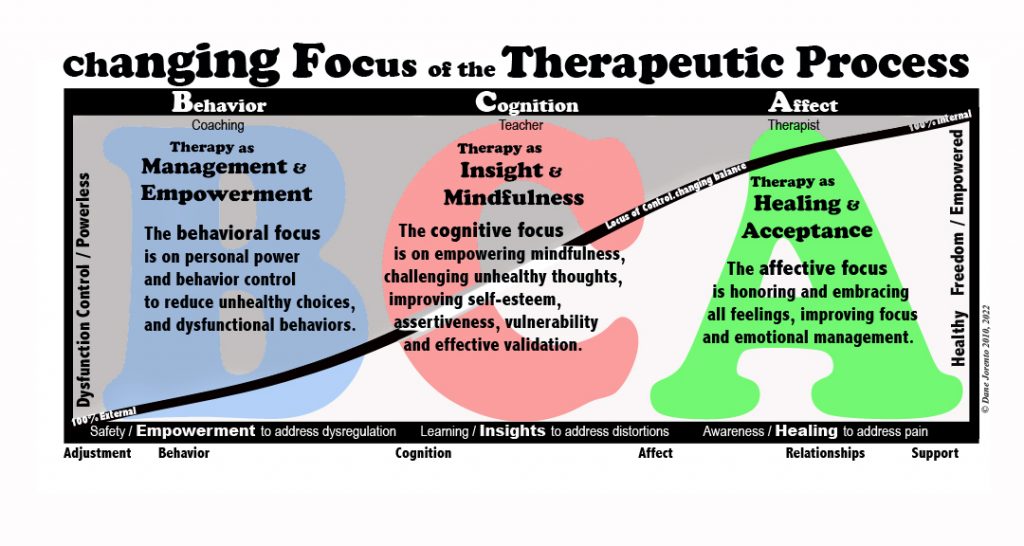Part 4:
Shifting Focus

The BCA approach mindfully selects the therapeutic focus and roles throughout the entire mental health therapy process. This mindful approach includes awareness of the shifting focus from a snap shot to a process, and from a focus to a role.
Shifting from a snap shot to a process is moving from the perspective of seeing one event or one moment in time, to many events and the process of moving through time. In recognizing these shifts and changes, not only can real life issues be more clearly understood, but retro-active and proactive interventions also become possible. If change and growth isn’t built into the skills and interventions, then it is quite possible that a client may re-develop new issues, or even on-going issues, from old problems.
A proactive example would be if a six-year old child is dealing with ADHD issues, and one of the useful interventions is having their parents define specific study times. At that time, it works well, but such a strategy will not be as effective six to ten years later as a 12- or 16-year old. Furthermore, if the parents are still managing the 16-year old’s studying habits, new issues and dysfunctions are possibly being created related to the teen learning self-management skills.
A retro-active real-life example is when I had a 15-year-old client who was highly anxious and fearful from having a seizure when she was 12. She had spent 3 years worrying about it happening again. Her parents had taken her to many doctors, but there were no medical reasons for why she had the seizure, or any expectation of future medical issue of seizures. In short, what happened shouldn’t have happened, but it did. In this case the first step was recognizing the one-time event for what it was, a glitch in the system and not likely to ever be repeated. Explaining that life is messy, mistakes happen and glitches in how our body works are actually quite frequent occurrences. The client and her parents had done everything possible to discovery any medical problems but none were discovered. The client’s anxiety and fears were real, but the problem was long gone. So, redefining the seizure as a glitch and not an on-going medical issue, helped the client significantly reduce her fears and anxiety.
A related analogy I often used with clients is comparing computers and people. When a computer freezes up, do you think the computer is broken and throw it out? Or, that there is just as a bug in the system and restart it. Obviously, we are all aware that computers have frequent glitches in their operation. Now, which is more complicated – a computer or a person. I would say people are much more complex than computers. So, recognizing that people also can have glitches help them to emotionally and thoughtfully deal with the occasional and unexpected bugs in our system.
Shifting from a focus to a role involves recognizing the most effective or appropriate therapeutically helpful role based on what specific issue or dysfunction is being addressed.
If the identified issue or dysfunction is behavior, then a coaching role to help change and adapt behaviors is more useful. For example, coaching someone on how to slow their breath and relax when they start feeling emotionally overwhelmed.
For a cognitive focus, a teaching approach providing information, perspective and insights is usually most effective. Such as explaining why slowing our breath can help us calm down and manage emotions more effectively.
When the struggles are with managing emotional power, then a therapeutic role of providing support, empathy or reflections might be the most appreciated and effective intervention.
Finally, the BCA perspective is that all emotions are functional and just provide power. So, the therapeutic role is about validating their emotions as normal and acceptable. This acceptance of all emotions, especially strong and overwhelming emotions is very difficult for many people to understand and embrace, but in listening to them closely, their issues and concerns are usually related to the where, when, how and why of emotions, as well as the start and expression of their emotions. (note: the BCA perspective of emotions as power, so all emotions are functional and acceptable will be extensively discussed.)

Pingback: BCA Holistic Mental Health Therapy: Overview - Emotional Powers
Pingback: BCA Holistic Mental Health Therapy: Cognitive Interweave - Emotional Powers
Pingback: BCA Holistic Mental Health Therapy: Defining Emotions as Power - Emotional Powers
Pingback: BCA Holistic Mental Health Therapy: Quality Process - Emotional Powers